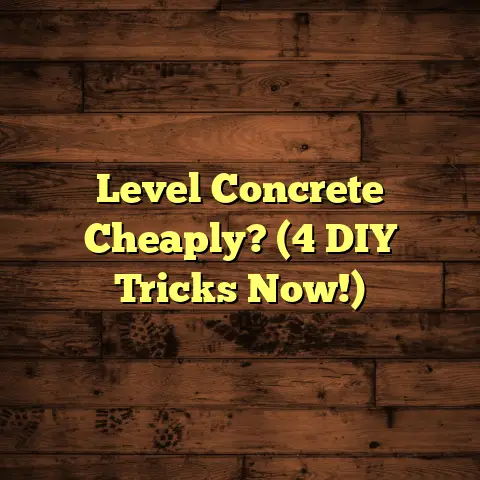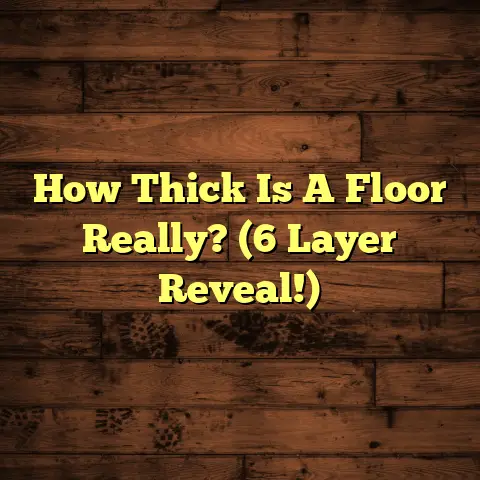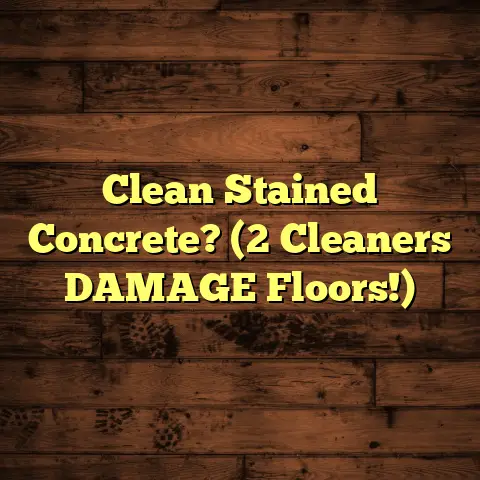Epoxy Over Vinyl? (3 Problems To Expect!)
I’ve witnessed everything, from failed DIY projects to remarkable makeovers.
Lately, I’ve noticed a huge surge in folks wanting to jazz up
their spaces with epoxy coatings.
And honestly, who can blame
them?
Epoxy floors are tough, look fantastic, and are super
easy to clean.
But here’s the thing: while epoxy is amazing, slapping it over
any surface isn’t a guaranteed win.
Today, we’re diving
deep into a specific scenario: applying epoxy over vinyl flooring.
It’s a question I get asked all the time, and while it can
work, you need to be aware of the potential pitfalls.
Trust me,
being informed before you start is way better than dealing
with a flooring nightmare later.
So, grab a coffee, settle in, and let’s get real about the challenges of epoxy over vinyl.
Section 1: Understanding Epoxy and Vinyl Flooring
First, let’s make sure we’re on the same page about these two materials.
What is Epoxy?
Epoxy is a thermosetting polymer that’s created by mixing a
resin and a hardener.
When these two components combine, a
chemical reaction occurs, resulting in a rigid, durable, and
chemical-resistant material.
Think of it as liquid plastic that hardens into a super-tough surface.
In flooring, epoxy is often used to create seamless, glossy
surfaces.
It’s popular in garages, basements, kitchens, and
even living rooms.
You can add pigments, flakes, and other
decorative elements to create truly unique looks.
What is Vinyl Flooring?
Vinyl flooring is a synthetic flooring option made from
polyvinyl chloride (PVC) and other compounds.
It comes in
various forms, including:
- Sheet vinyl: Large, continuous rolls.
- Vinyl tiles: Individual squares.
- Luxury vinyl planks (LVP): Designed to mimic wood.
- Luxury vinyl tiles (LVT): Designed to mimic stone or ceramic.
Vinyl is known for being affordable, water-resistant, and easy
to install.
It’s a common choice for bathrooms, kitchens, and
other areas prone to moisture.
The Bonding Process: Why Substrate Matters
Epoxy bonds to a surface through a process called adhesion.
Think of it like glue sticking to paper.
The epoxy needs to
“grab” onto the substrate (the surface it’s being applied to)
to form a strong, lasting bond.
A rough, porous surface provides more “grabbing points” for the
epoxy, leading to better adhesion.
That’s why concrete, which
is naturally porous, is often an ideal substrate for epoxy.
But what about smooth, non-porous surfaces like vinyl? That’s where things get tricky.
Section 2: Problem 1 – Poor Adhesion Issues
This is the big one.
Poor adhesion is the most common and
frustrating problem you’ll face when applying epoxy over vinyl.
Factors Leading to Poor Adhesion
Several factors can contribute to this issue:
- Surface Preparation: This is HUGE.
If the vinyl isn’t
perfectly clean and properly prepped, the epoxy won’t stick.
We’re talking about removing all traces of dirt, grease,
wax, and any previous coatings. - Contamination: Even a tiny amount of oil or silicone
can prevent the epoxy from bonding. - Moisture: Epoxy and moisture are enemies.
If the vinyl
or the subfloor underneath is damp, the epoxy will struggle
to adhere. - Vinyl’s Smooth Surface: As I mentioned earlier, vinyl’s
non-porous nature makes it difficult for epoxy to grip.
Testing for Adhesion: The Peel Test
Before you commit to coating your entire floor, always do a
peel test.
Here’s how:
- Prepare a small area: Clean and prep a small section of
the vinyl flooring as you would for the entire project. - Apply epoxy: Apply a small amount of epoxy to the prepared
area. - Let it cure: Allow the epoxy to fully cure according to
the manufacturer’s instructions (usually 24-72 hours). - Peel test: Use a sharp utility knife to score around the
edges of the epoxy patch.
Then, try to peel it up using a
putty knife or scraper.
If the epoxy peels up easily, you have an adhesion problem.
Don’t proceed with the full project until you’ve addressed
the issue!
Consequences of Poor Adhesion
So, what happens if the epoxy doesn’t stick properly?
Get ready
for some potential headaches:
- Bubbling: Air or moisture trapped between the epoxy and
the vinyl can cause unsightly bubbles to form. - Peeling: The epoxy can start to peel away from the vinyl,
especially in high-traffic areas. - Premature Wear: Without a solid bond, the epoxy layer
won’t be as durable and will wear down much faster.
I’ve seen cases where entire epoxy floors have failed within
months due to poor adhesion.
It’s a costly and frustrating
experience that can be avoided with proper preparation and
testing.
Section 3: Problem 2 – Moisture Trapping
Moisture is a silent enemy that can wreak havoc on your flooring
project.
And vinyl, while water-resistant on its surface, can
actually trap moisture underneath.
How Vinyl Traps Moisture
Vinyl flooring isn’t breathable.
This means that if moisture
gets trapped between the vinyl and the subfloor (usually
concrete or wood), it can’t easily escape.
This moisture can come from several sources:
- Humidity: High humidity levels can cause moisture to
condense under the vinyl. - Leaks: Plumbing leaks or spills can seep under the vinyl.
- Groundwater: Moisture can wick up through concrete slabs,
especially in basements.
Signs of Moisture Issues
Keep an eye out for these telltale signs of moisture problems:
- Mold or Mildew: A musty odor or visible mold growth
along the edges of the vinyl. - Warping: The vinyl may start to buckle or warp.
- Discoloration: Staining or discoloration of the vinyl.
- Efflorescence: A white, powdery deposit on the surface
of the concrete subfloor (if visible).
The Importance of Moisture Testing
Before you even think about applying epoxy, you must test
for moisture.
There are a few ways to do this:
- Calcium Chloride Test (ASTM F1869): This involves placing
a container of calcium chloride on the concrete subfloor,
sealing it, and measuring how much moisture it absorbs over
a period of time.
This is the gold standard for measuring
moisture vapor emission rate (MVER). - Relative Humidity (RH) Test (ASTM F2170): This involves
drilling small holes in the concrete and inserting probes to
measure the relative humidity within the slab.
These tests will give you a clear picture of the moisture levels
in your subfloor.
If the levels are too high, you’ll need to
address the issue before proceeding with the epoxy.
Moisture Barriers: Your First Line of Defense
If moisture is a concern, consider using a moisture barrier.
These are typically liquid-applied membranes that are rolled
or brushed onto the subfloor before installing the vinyl.
They create a waterproof layer that prevents moisture from wicking up into the flooring system.
The Cost of Ignoring Moisture
Trust me, ignoring moisture problems is a recipe for disaster. Here’s what can happen:
- Delamination: The epoxy can delaminate (separate) from
the vinyl due to moisture pressure. - Mold Growth: Trapped moisture can create a breeding
ground for mold and mildew, which can be a health hazard. - Structural Damage: In severe cases, moisture can damage
the subfloor, leading to costly repairs.
I’ve seen projects where homeowners tried to cut corners by
skipping moisture testing and barriers.
They ended up having
to tear out the entire floor and start over.
Learn from their
mistakes!
Section 4: Problem 3 – Flexibility and Movement Concerns
Vinyl is a flexible material.
That’s one of the reasons why
it’s so comfortable to walk on.
But this flexibility can
pose a challenge when you’re applying a rigid coating like epoxy.
The Flexibility Factor
When you apply epoxy over vinyl, you’re essentially creating a composite system: a flexible layer (vinyl) topped with a rigid layer (epoxy).
The problem is that these two materials react differently to temperature changes and stress.
Expansion and Contraction
As temperatures fluctuate, materials expand and contract.
Vinyl
has a higher coefficient of thermal expansion than epoxy.
This
means that it expands and contracts more than epoxy when exposed
to temperature changes.
Assessing the Condition of the Vinyl
Before applying epoxy, carefully assess the condition of the vinyl flooring. Look for:
- Loose or Damaged Areas: If the vinyl is loose, damaged,
or poorly adhered to the subfloor, it’s not a good candidate
for epoxy. - Excessive Movement: If the vinyl flexes or moves excessively
when you walk on it, it’s likely to cause problems with the
epoxy. - Age and Wear: Older vinyl flooring may be more brittle
and prone to cracking, which can exacerbate movement issues.
Long-Term Effects
If these movement issues aren’t addressed, they can lead to:
- Cracking: Cracks in the epoxy layer, especially along
seams or edges. - Chipping: Chipping of the epoxy, particularly in high-traffic areas.
- Debonding: The epoxy can eventually debond from the vinyl
due to constant stress and movement.
These problems can not only affect the appearance of your floor but also compromise its durability and longevity.
Conclusion
So, there you have it: the three main problems to expect when applying epoxy over vinyl flooring.
- Poor Adhesion: Ensuring a strong bond between the epoxy
and vinyl is crucial. - Moisture Trapping: Preventing moisture from getting trapped
under the vinyl is essential to avoid mold and delamination. - Flexibility and Movement: Addressing the differences in
flexibility and expansion between the vinyl and epoxy is key
to preventing cracking and chipping.
Applying epoxy over vinyl isn’t impossible, but it requires careful planning, thorough preparation, and a good understanding of the potential challenges.
Don’t rush into it!
Take the time to assess your situation,
conduct the necessary tests, and choose the right products and
techniques.
Call to Action
I hope this article has given you a better understanding of the challenges involved in applying epoxy over vinyl flooring.
Have you had any experiences with this type of project?
What
challenges did you face, and how did you overcome them?
Share
your thoughts and questions in the comments below!
And if you’re feeling overwhelmed or unsure about any aspect
of the process, don’t hesitate to seek professional advice.
A qualified flooring contractor can assess your situation and
recommend the best course of action.
Good luck with your flooring project!





